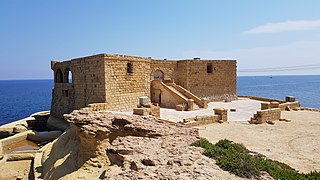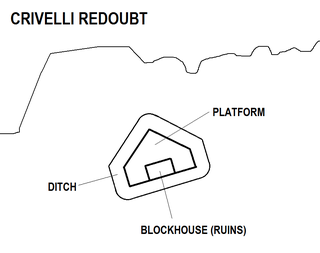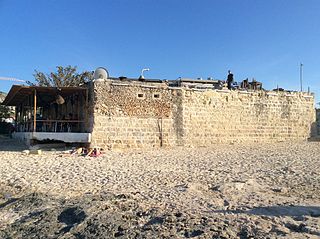
Qolla l-Bajda Battery is an artillery battery in Żebbuġ, Gozo, Malta. It was built by the Order of Saint John in 1715 and 1716 as one of a series of coastal fortifications around the coasts of the Maltese Islands. It retained its original layout until the late 1970s, when it was converted into a discothèque and snack bar known as Rook and major alterations were made to the battery. The building, in the midst of a legal battle between the government and a private company, is now abandoned and in a dilapidated state.

Mistra Battery, formerly also known as Despirasse Battery, is an artillery battery in Mistra Bay, Mellieħa, Malta. It was built by the Order of Saint John in the 18th century as one of a series of coastal fortifications around the coasts of the Maltese Islands.

Dellia Battery, also known as Vendôme Battery or Pwales Right Battery, was an artillery battery in Xemxija Bay, limits of St. Paul's Bay, Malta. It was built by the Order of Saint John in 1715 as one of a series of coastal fortifications around the coasts of the Maltese Islands. It was demolished in 1924, but the coats of arms and inscription which were located above the main entrance still exist and are now a monument.

Ferretti Battery, also known as Qajjenza Battery or Saint George's Battery, is an artillery battery in the village of Qajjenza, within the limits of Birżebbuġa, in Malta. It was built by the Order of Saint John in 1715 and 1716 as one of a series of fortifications around the coasts of the Maltese Islands. A restaurant exists within the walls of the battery, serving Mediterranean cuisine.

Vendôme Battery, also known as Ta' Maċċu Battery, is an artillery battery near Armier Bay, limits of Mellieħa, Malta. It was built by the Order of Saint John in 1715–1716 as one of a series of coastal fortifications around the Maltese Islands.

Crivelli Redoubt, also known as Barriera Redoubt or Armier Redoubt, is a redoubt in Armier Bay, Mellieħa, Malta. It was built by the Order of Saint John in 1715–1716 as part of a series of coastal fortifications around the Maltese Islands. Today, the redoubt is in good condition.

Tal-Bir Redoubt, also known as Wied Musa Redoubt, is a redoubt in the limits of Mellieħa, Malta. It was built by the Order of Saint John in 1715–1716 as one of a series of coastal fortifications around the Maltese Islands. Today, the redoubt lies in ruins.

Qortin Redoubt, also known as Eskalar Redoubt, is a redoubt in the limits of Mellieħa, Malta. It was built by the Order of Saint John in 1715–1716 as one of a series of coastal fortifications around the Maltese Islands. The redoubt still exists, but it has some modern modifications.

Wied Musa Battery, also known as Swatar Battery, is a former artillery battery in Marfa, limits of Mellieħa, Malta. It was built by the Order of Saint John in 1714–1716 as one of a series of coastal fortifications around the Maltese Islands.
Fedeau Battery was an artillery battery in Mellieħa, Malta. It was built by the Order of Saint John in 1714-16 as part of a series of coastal fortifications around the Maltese Islands, and demolished in the 20th century.
Mellieħa Redoubt was a redoubt in Mellieħa, Malta. It was built by the Order of Saint John in 1715–1716 as one of a series of coastal fortifications around the Maltese Islands. The limestone structure was demolished in the 19th century.
The Maħsel Battery was an artillery battery in Marsaskala, Malta. It was built by the Order of Saint John in 1714–1716 as one of a series of coastal fortifications around the coasts of the Maltese Islands. The battery no longer exists.

Riħama Battery is an artillery battery in Marsaskala, Malta. It was built by the Order of Saint John in 1714–1716 as one of a series of coastal fortifications around the coasts of the Maltese Islands. The battery still exists, although it is in a dilapidated state with part of it having collapsed.

Pinto Battery, also known as Għżira Battery or Kechakara Battery, is a former artillery battery in Birżebbuġa, Malta. It was built by the Order of Saint John in 1715 and 1716 as one of a series of coastal fortifications around the coasts of the Maltese Islands. The battery has been heavily altered over time, and the blockhouse now houses a bar and a garage, while the gun platform and parapet have been largely destroyed, with only the general outline still visible.

Qalet Marku Battery, also known as D'Orbeau Battery, was an artillery battery in Baħar iċ-Ċagħaq, within the limits of Naxxar, Malta. It was built in 1715–1716 by the Order of Saint John as one of a series of coastal fortifications around the Maltese Islands. The battery has been largely destroyed, but some remains can still be seen.
Għallis Battery, also known as Pondéves Battery, was an artillery battery in Magħtab, within the limits of Naxxar, Malta. It was built in 1715–1716 by the Order of Saint John as one of a series of coastal fortifications around the Maltese Islands. The battery has been mostly ruined, but some debris can still be seen.

Baħar iċ-Ċagħaq Redoubt is a redoubt in Baħar iċ-Ċagħaq, within the limits of Naxxar, Malta. It was built in 1715–1716 by the Order of Saint John as one of a series of coastal fortifications around the Maltese Islands. Today, the redoubt still exists in relatively good condition.

Arrias Battery, also known as Xemxija Battery or Pwales Left Battery, is an artillery battery in Xemxija, limits of St. Paul's Bay, Malta. It was built by the Order of Saint John in 1715–1716 as one of a series of coastal fortifications around the Maltese Islands. The battery still exists, although it has modern alterations, and it is used as a restaurant.

Ramla Right Battery, also known as Gironda Battery or Nadur Battery, was an artillery battery in Ramla Bay, in the limits of Nadur on the island of Gozo, Malta. It was built by the Order of Saint John in 1715–1716 as one of a series of coastal fortifications around the Maltese Islands. The battery now lies in ruins.

Wardija Battery was an artillery battery in Wardija, a hilltop in the limits of St. Paul's Bay, on the northern coast of Malta. It was built by the British in 1915, and saw use during World War I. It became obsolete following the construction of Fort Campbell in 1938.



















